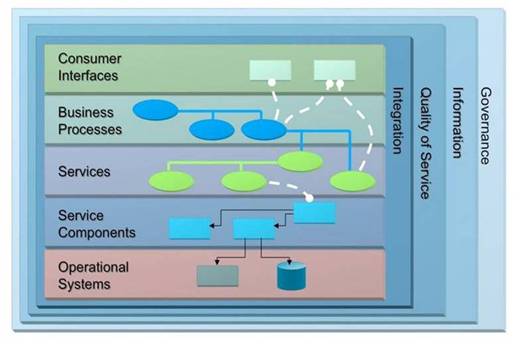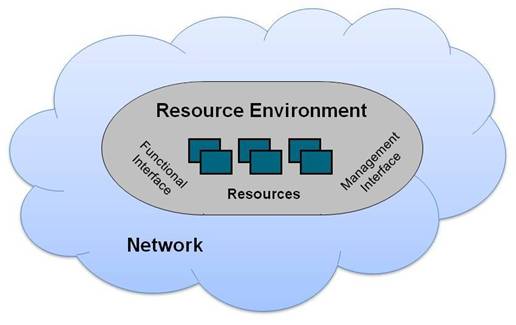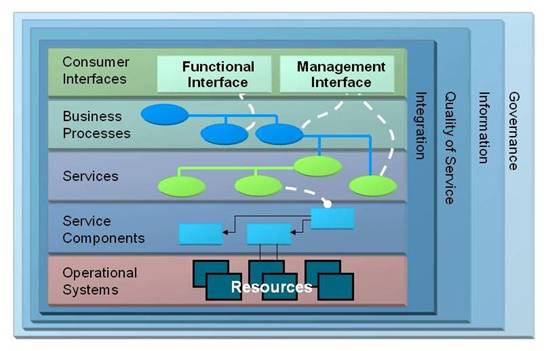Cloud Computing Portability and Interoperability – Cloud Computing and SOA
The SOA Reference Architecture
In the service-oriented style of Enterprise Architecture, monolithic applications are replaced by sets of loosely-coupled services. The SOA Reference Architecture shows the conceptual building blocks of an SOA solution, and how they relate to each other. It can be used as a basis for specific solution models, and also for models of larger SOA systems, including those of enterprise SOA. In this context, the SOA Reference Architecture [SOARA] applies to the delivery of services from the cloud and can help to clarify the essential building blocks that can enhance interoperability and portability.

The SOA Reference Architecture
Five of the layers include processing that is specific to particular application functions. These, the functional layers, are shown on top of the other four, which constitute a generic services platform.
Existing application assets and other programs and resources are in the Operational Systems layer. This supports the Service Components layer, which contains software components that help to perform services and may leverage existing assets. Virtualization is performed in this layer. The central layer of the model is the Services layer, which contains the services, built from the components in the Service Components layer. The Business Processes layer contains compositions of the services in the Services layer. These are combinations of services that support business processes, and can be formed dynamically. The final functional layer is the Consumer Interfacess layer, which contains the interfaces to people and software components that use the services.
The services platform comprises four layers. The Integration layer performs functions concerned with the integration of other building blocks. The Quality of Service layer handles quality aspects of system operation. This includes aspects relating to management and security. The Information layer is concerned with the processing of information within the system. The Governance layer is concerned with system functions that help ensure adherence to applicable regulations and policies. The Integration layer is directly concerned with interoperability. The other layers are important for interoperability and portability too.
Cloud Services
The essential concept of cloud computing, illustrated in Cloud Service, is that resources, which may be processing hardware, application platforms, or application software, are provided as a service, in a resource environment that enables them to be deployed and used, and with access via a communications network.
The environment has a functional interface, by which users can access the resource functions, and a management interface, by which users can deploy and configure them, and take advantage of the essential cloud computing characteristics of on-demand self-service, rapid elasticity, and measured service. This is shown in Cloud Service Interfaces.

Application of the SOA Reference Architecture to Cloud Services
The resource environment can be organized in accordance with the SOA Reference Architecture, as shown in Resource Environment in SOA.

The resources are in the Operational Systems layer, and the functional and management interfaces are in the Consumer Interfaces layer.
This applies to all forms of cloud computing: IaaS, PaaS, and SaaS. The relation to the DCRM, however, is different for SaaS and PaaS or IaaS.
For SaaS, the operational systems are applications programs. The functional layers of the SOA Reference Architecture are in the applications component of the DCRM, while the cross-cutting layers of the services platform are in the DCRM platforms component.
For PaaS, all layers of the SOA Reference Architecture are in the DCRM platforms component. For IaaS they are all in the infrastructure component.